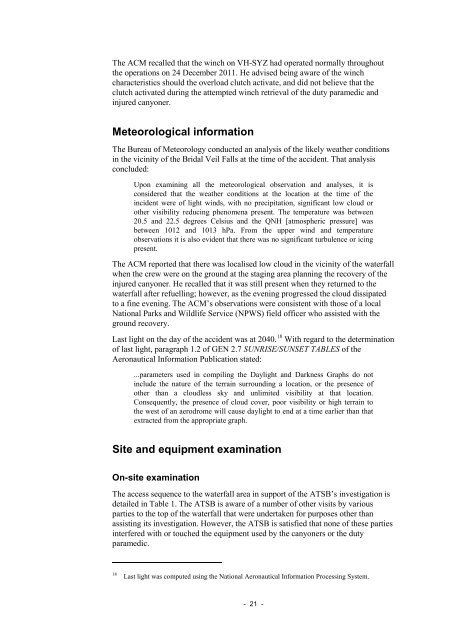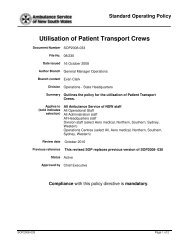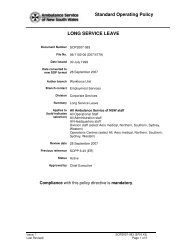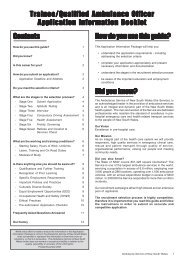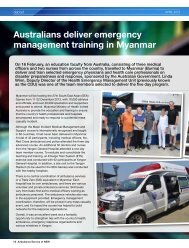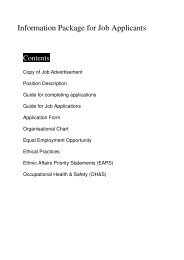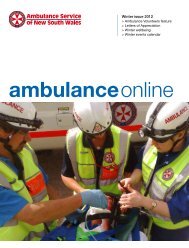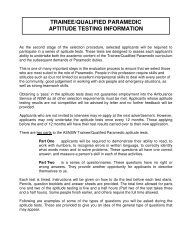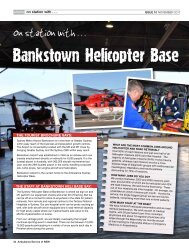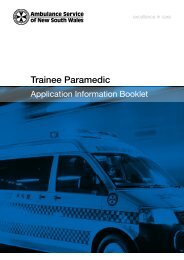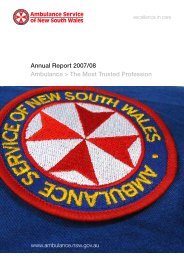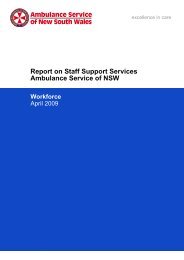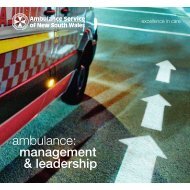atsb final report released 16 may 2013 - Ambulance Service of NSW
atsb final report released 16 may 2013 - Ambulance Service of NSW
atsb final report released 16 may 2013 - Ambulance Service of NSW
You also want an ePaper? Increase the reach of your titles
YUMPU automatically turns print PDFs into web optimized ePapers that Google loves.
The ACM recalled that the winch on VH-SYZ had operated normally throughoutthe operations on 24 December 2011. He advised being aware <strong>of</strong> the winchcharacteristics should the overload clutch activate, and did not believe that theclutch activated during the attempted winch retrieval <strong>of</strong> the duty paramedic andinjured canyoner.Meteorological informationThe Bureau <strong>of</strong> Meteorology conducted an analysis <strong>of</strong> the likely weather conditionsin the vicinity <strong>of</strong> the Bridal Veil Falls at the time <strong>of</strong> the accident. That analysisconcluded:Upon examining all the meteorological observation and analyses, it isconsidered that the weather conditions at the location at the time <strong>of</strong> theincident were <strong>of</strong> light winds, with no precipitation, significant low cloud orother visibility reducing phenomena present. The temperature was between20.5 and 22.5 degrees Celsius and the QNH [atmospheric pressure] wasbetween 1012 and 1013 hPa. From the upper wind and temperatureobservations it is also evident that there was no significant turbulence or icingpresent.The ACM <strong>report</strong>ed that there was localised low cloud in the vicinity <strong>of</strong> the waterfallwhen the crew were on the ground at the staging area planning the recovery <strong>of</strong> theinjured canyoner. He recalled that it was still present when they returned to thewaterfall after refuelling; however, as the evening progressed the cloud dissipatedto a fine evening. The ACM’s observations were consistent with those <strong>of</strong> a localNational Parks and Wildlife <strong>Service</strong> (NPWS) field <strong>of</strong>ficer who assisted with theground recovery.Last light on the day <strong>of</strong> the accident was at 2040. 18 With regard to the determination<strong>of</strong> last light, paragraph 1.2 <strong>of</strong> GEN 2.7 SUNRISE/SUNSET TABLES <strong>of</strong> theAeronautical Information Publication stated:...parameters used in compiling the Daylight and Darkness Graphs do notinclude the nature <strong>of</strong> the terrain surrounding a location, or the presence <strong>of</strong>other than a cloudless sky and unlimited visibility at that location.Consequently, the presence <strong>of</strong> cloud cover, poor visibility or high terrain tothe west <strong>of</strong> an aerodrome will cause daylight to end at a time earlier than thatextracted from the appropriate graph.Site and equipment examinationOn-site examinationThe access sequence to the waterfall area in support <strong>of</strong> the ATSB’s investigation isdetailed in Table 1. The ATSB is aware <strong>of</strong> a number <strong>of</strong> other visits by variousparties to the top <strong>of</strong> the waterfall that were undertaken for purposes other thanassisting its investigation. However, the ATSB is satisfied that none <strong>of</strong> these partiesinterfered with or touched the equipment used by the canyoners or the dutyparamedic.18Last light was computed using the National Aeronautical Information Processing System.- 21 -


